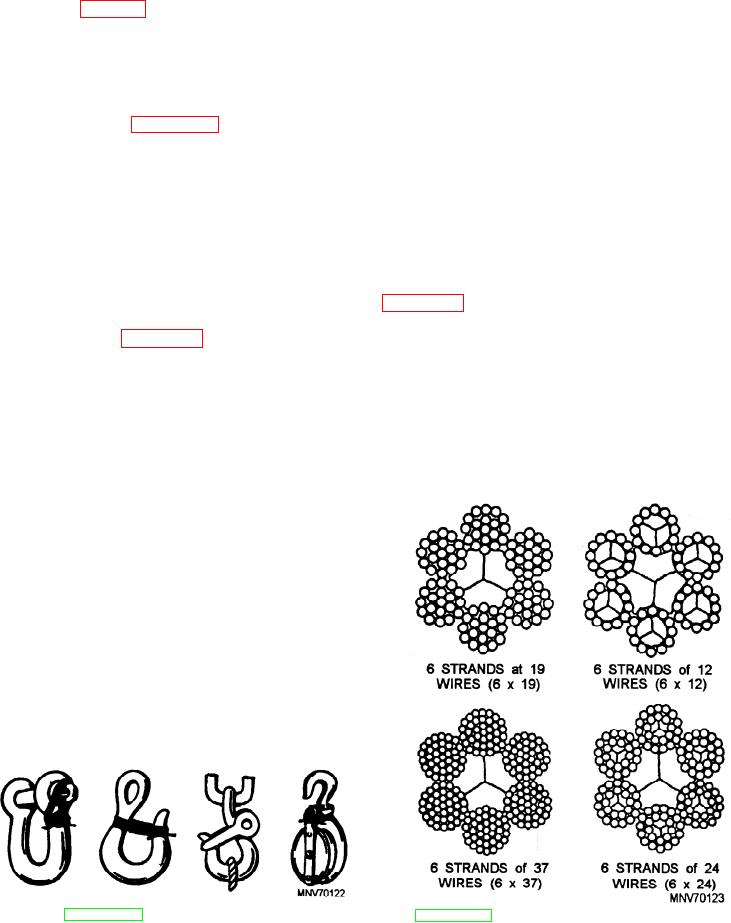
purpose for which the rope is intended. A number of
RACKING SEIZING
strands are laid together to form the wire rope itself.
Use racking seizing where there is an unequal strain
Wire rope is designated by the number of strands per
on the two parts of the line. Lay turns around the line in
rope and the numbers of wires per strand. Thus a 6 x 19
figure-eight fashion for about ten turns. Then pass the
rope has 6 strands with 19 wires per strand but can have
seizing stuff back in the opposite direction, and take a
the same outside diameter as a 6 x 37 wire rope, which
row of turns over the top of the racking as is done in a
has 6 strands with 37 wires of much smaller size per
round seizing (fig. 4-25, view D). Finish off by passing
strand. Wire rope made up of a large number of small
the endthroughthe eye again, and tie an overhand knot.
wires is flexible, but the small wires break so easily that
THROAT SEIZING
the wire rope is not resistant to external abrasion. Wire
rope made up of a smaller number of larger wires is
Throat seizing is actually a round seizing and is
more resistant to external abrasion but is less flexible.
used wherever a temporary eye is needed in the middle
of a line. View E of figure 4-25 shows a completed
The strands of the wire rope are laid up around a
throat seizing.
central core, which may be fiber, a single strand of wire,
or an independent wire rope. A fiber core contributes
MOUSING HOOKS AND SHACKLES
flexibility, cushions the strands as the wire rope
A hook is moused to keep slings, straps, and so
contracts under strain, and holds a portion of lubricant
forth, from slipping out of the hook and to strengthen
for continuous lubrication. A wire core is stronger than
the hook if there is the danger that the load will bend it.
fiber and can be used where conditions such as high
If the purpose of the mousing is to keep a strap or sling
temperatures would damage fiber. Some end views of
from escaping, marline or rope yarn may be used. If the
the arrangements of strands in wire ropes are shown in
purpose is to strengthen the hook, seizing wire or a
shackle may be used. the proper method for each
Wire rope may be fabricated by either of two
purpose is shown in figure 4-26.
methods. If the strands of wires are shaped to conform
Shackles are moused whenever there is the danger
to the curvature of the finished rope before their laying
that the shackle pin will work loose and come out
up, the wire rope is termed preformed. If the strands are
because of vibration. Several turns are taken through
not shaped before fabrication, the wire rope is termed
the eye of the shackle pin and around the shackle itself
non-preformed. When cut, preformed wire rope tends
with seizing wire so the pin cannot turn.
not to untwist and is more flexible than non-preformed
wire rope.
WIRE ROPE
Wire rope may have few applications on some Navy
ships, but on minesweeping ships, wire rope is
extremely important. The following information on
wire rope is of a general nature. Wire rope used in
minesweeping operations will be discussed in later
chapters on minesweeping.
CONSTRUCTION OF WIRE ROPE
The basic unit of wire rope construction is the
individual wire made of steel or other metal in various
sizes. These wires are laid together to form strands. The
number of wires in a strand varies according to the
Figure 4-26.--Methods of mousing.
Figure 4-27.--Arrangement of strands in wire rope.
4-20

